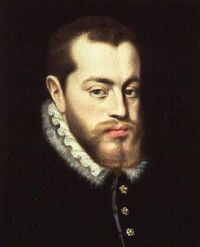Lord Akiyama (talk | contribs) No edit summary |
No edit summary |
||
| (6 intermediate revisions by 2 users not shown) | |||
| Line 1: | Line 1: | ||
| − | [[File:PhilipII.jpg|right|200px]] |
+ | [[File:PhilipII.jpg|thumb|right|200px]] |
| − | '''Philip II''' (c.21 May 1527–13 September 1598) was the ruler of one of the world's largest empires which included territories in every continent then known to Europeans. |
+ | '''Philip II''' (c.21 May 1527–13 September 1598) was the ruler of one of the world's largest empires which included territories in every continent then known to Europeans. Also known as Philip the Prudent, he was primarily recognized as King of Spain from January 16, 1556 until his death. He is believed to be a [[Keepers of the Journal|Keeper of the Journal]]. |
| − | ==Possession of the |
+ | ==Possession of the Journal== |
| ⚫ | While growing up, Philip became familiar with the book known as the [[Shepherd's Journal]] that his great-grandfather [[Ferdinand V]] had hidden away in the family's castle in Spain from his father, Charles V. Charles did not think much of the book, himself believing that it was probably heretical. Philip, on the other hand, loved the mysterious book and would sneak a look into it whenever he could. |
||
| ⚫ | Upon being crowned King of Spain, Philip proudly flaunted the book at royal functions. He cared little of what the people thought of his obsession with the book, yet they would not doubt that it turned into a resourceful tool for the King. For Philip would draw inspiration from it for the spires of his palace, which would become known as El Escorial. |
||
| ⚫ | While growing up, Philip became familiar with the book known as the Shepherd's Journal that his great-grandfather [[Ferdinand V]] had hidden away in the family's castle in Spain from his father, Charles V. |
||
| ⚫ | It is not known how Philip would end up losing possession of the book to the [[House of Medici|de'Medici Family]], or when this occurred. All that is known is that the de'Medici would acquire the book and return it to Florence, Italy where it would be added to the growing collection at the Uffizi Gallery. |
||
| ⚫ | Upon being crowned King of Spain, Philip proudly flaunted the book at royal functions. |
||
| − | |||
| ⚫ | |||
==See also== |
==See also== |
||
| ⚫ | |||
| − | |||
| ⚫ | |||
[[Category:Historical Figures]] |
[[Category:Historical Figures]] |
||
Latest revision as of 06:21, 15 January 2013

Philip II (c.21 May 1527–13 September 1598) was the ruler of one of the world's largest empires which included territories in every continent then known to Europeans. Also known as Philip the Prudent, he was primarily recognized as King of Spain from January 16, 1556 until his death. He is believed to be a Keeper of the Journal.
Possession of the Journal[]
While growing up, Philip became familiar with the book known as the Shepherd's Journal that his great-grandfather Ferdinand V had hidden away in the family's castle in Spain from his father, Charles V. Charles did not think much of the book, himself believing that it was probably heretical. Philip, on the other hand, loved the mysterious book and would sneak a look into it whenever he could.
Upon being crowned King of Spain, Philip proudly flaunted the book at royal functions. He cared little of what the people thought of his obsession with the book, yet they would not doubt that it turned into a resourceful tool for the King. For Philip would draw inspiration from it for the spires of his palace, which would become known as El Escorial.
It is not known how Philip would end up losing possession of the book to the de'Medici Family, or when this occurred. All that is known is that the de'Medici would acquire the book and return it to Florence, Italy where it would be added to the growing collection at the Uffizi Gallery.